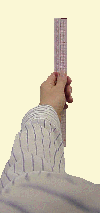|
Brooklyn College City University of New York |
Page1 |
 |
| Measuring distances by triangulation is a simple, straightforward, technique requiring no high-tech equipment, only a clear plastic ruler. But if used correctly, it gives reasonably accurate results. In this method you measure a distant object using a hand-held ruler as a scaling device. The following explains how this is done. |
 |
| STEP 1. TECHNIQUE: The first step is to take a clear, plastic ruler and hold it at arm's length. With your arm fully extended, you will see something like the picture at the right. You will see the ruler in your hand with the divisions of the ruler in plain view as illustrated to the right. This arm-extended position with the ruler visible in your hand is the position you will use to measure distance. Sometimes you may want to hold the ruler horizontally rather than vertically as in the picture. Generally, the ruler is held vertically to measure height or elevation, and horizontally to measure distance between points on the ground. |  |
 |
| STEP 2. CALIBRATION: Temporarily fasten a meter stick, yardstick, or large ruler to a wall. Step back from the wall a distance of 2 meters (or 2 yards) and facing the wall-mounted meter stick, hold your clear plastic ruler in the arm-extended position described above. Sight your hand-held ruler so that it appears to lie against the wall-mounted one. You will then see the two rulers juxtaposed, as in the picture to the right, in which the blue ruler on the left is your hand held one, and the yellow one on the right is the wall-mounted meter stick. Now determine the distance on the wall-mounted ruler cut off by successive major divisions on your hand-held ruler. In the example at the right, major divisions of the hand-held, blue ruler intercept 10 cm intervals on the yellow wall-mounted meterstick. Make sure your record in your notebook the cut-off (or "calibration") interval and the distance to the wall. |  |



|